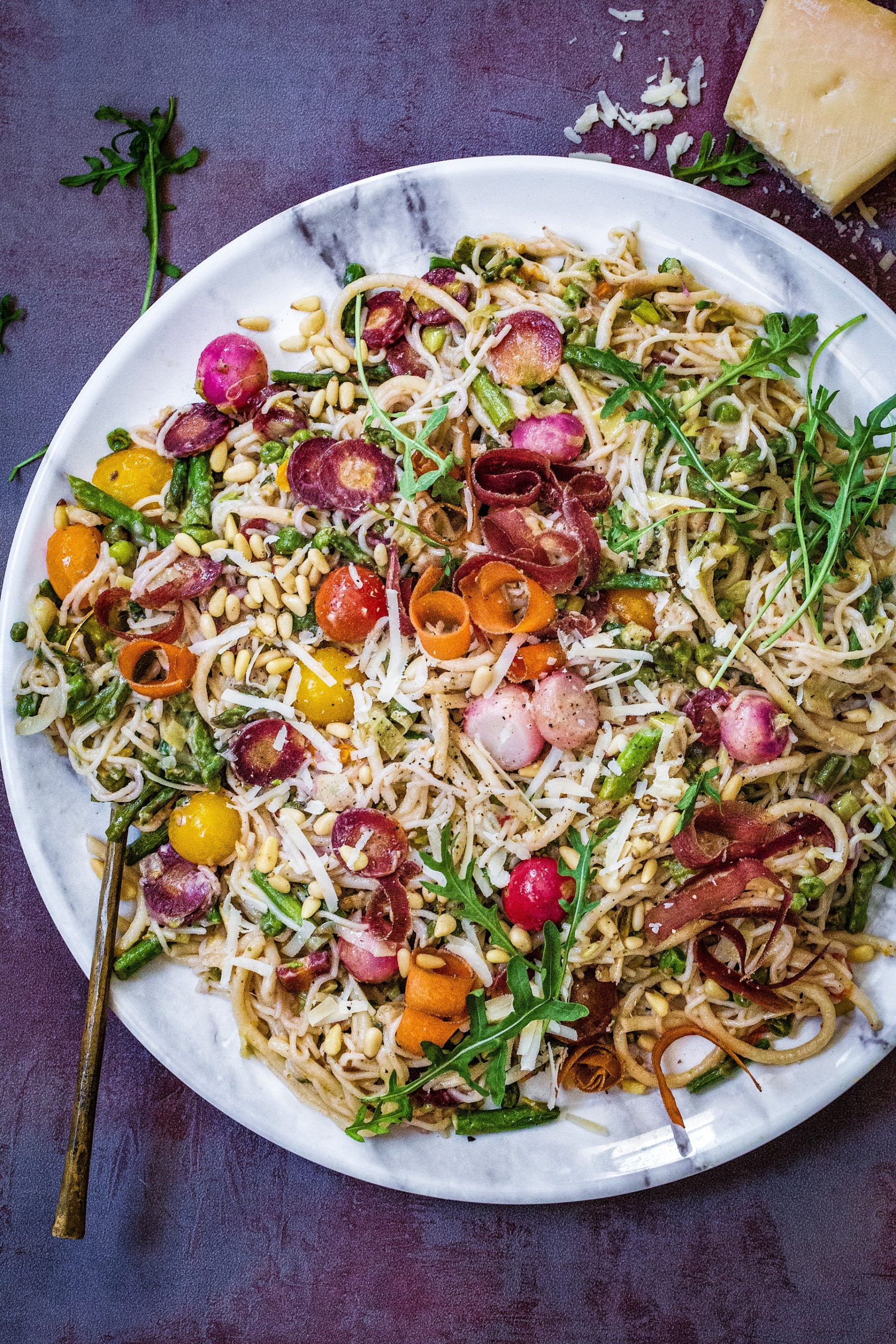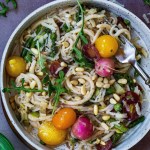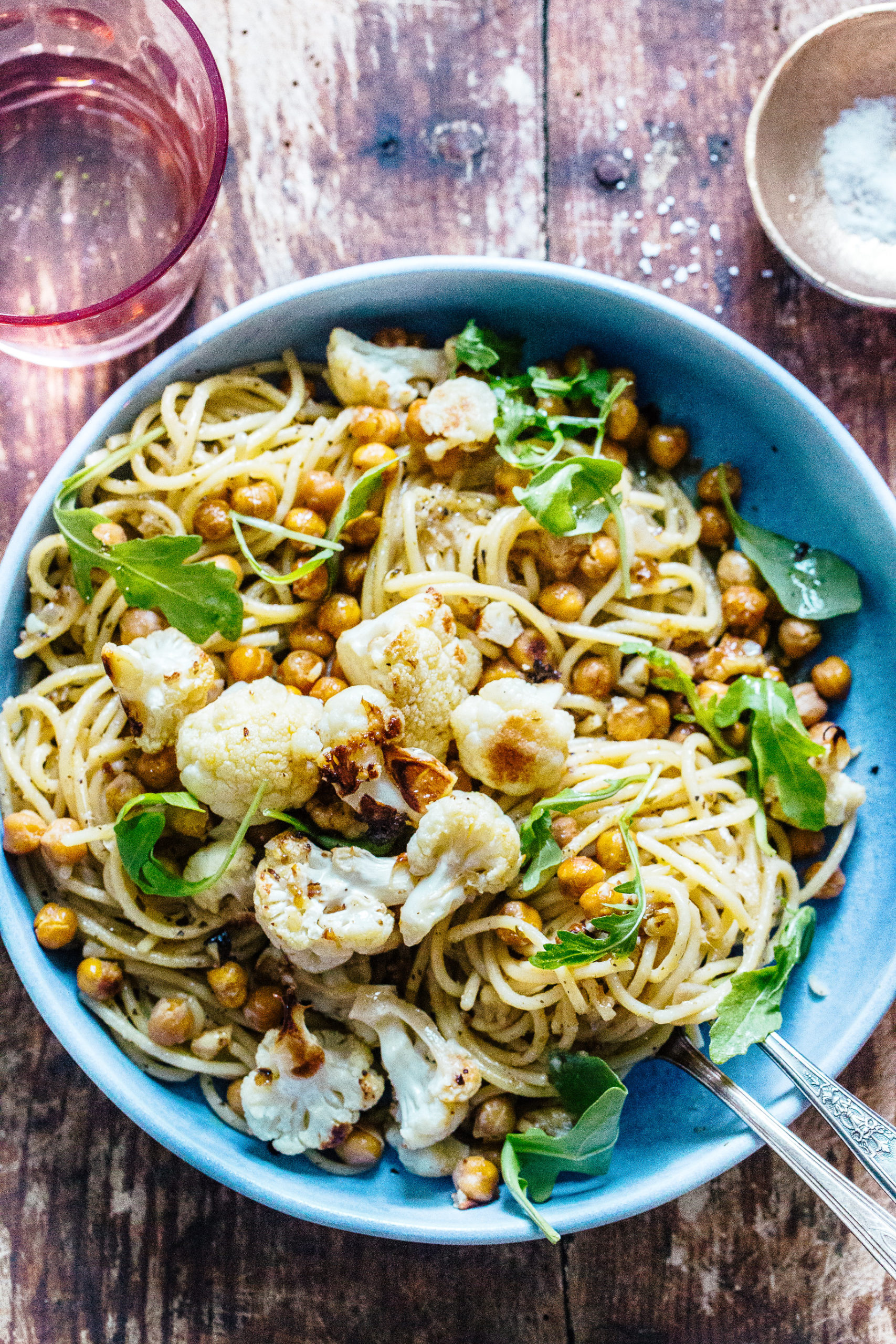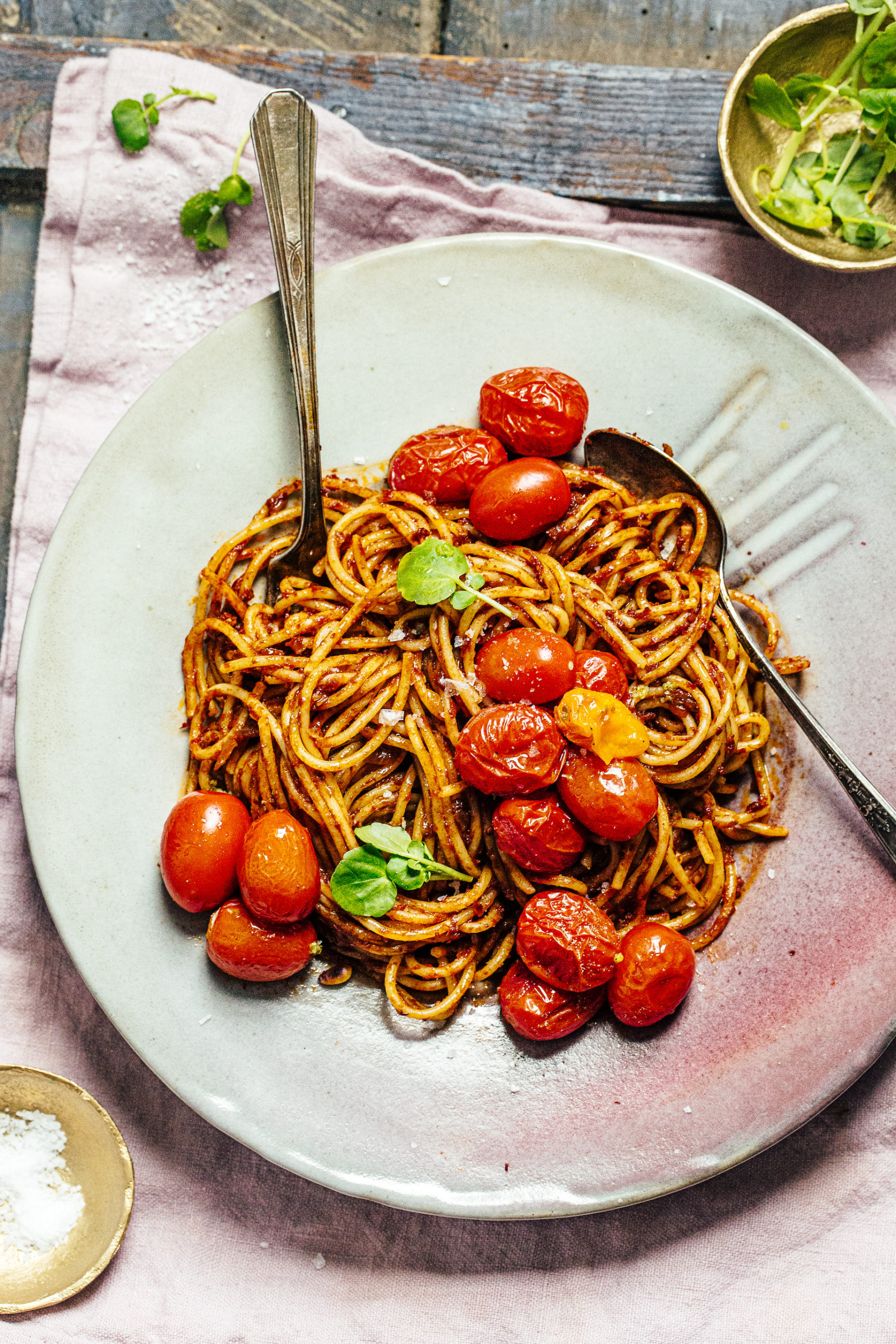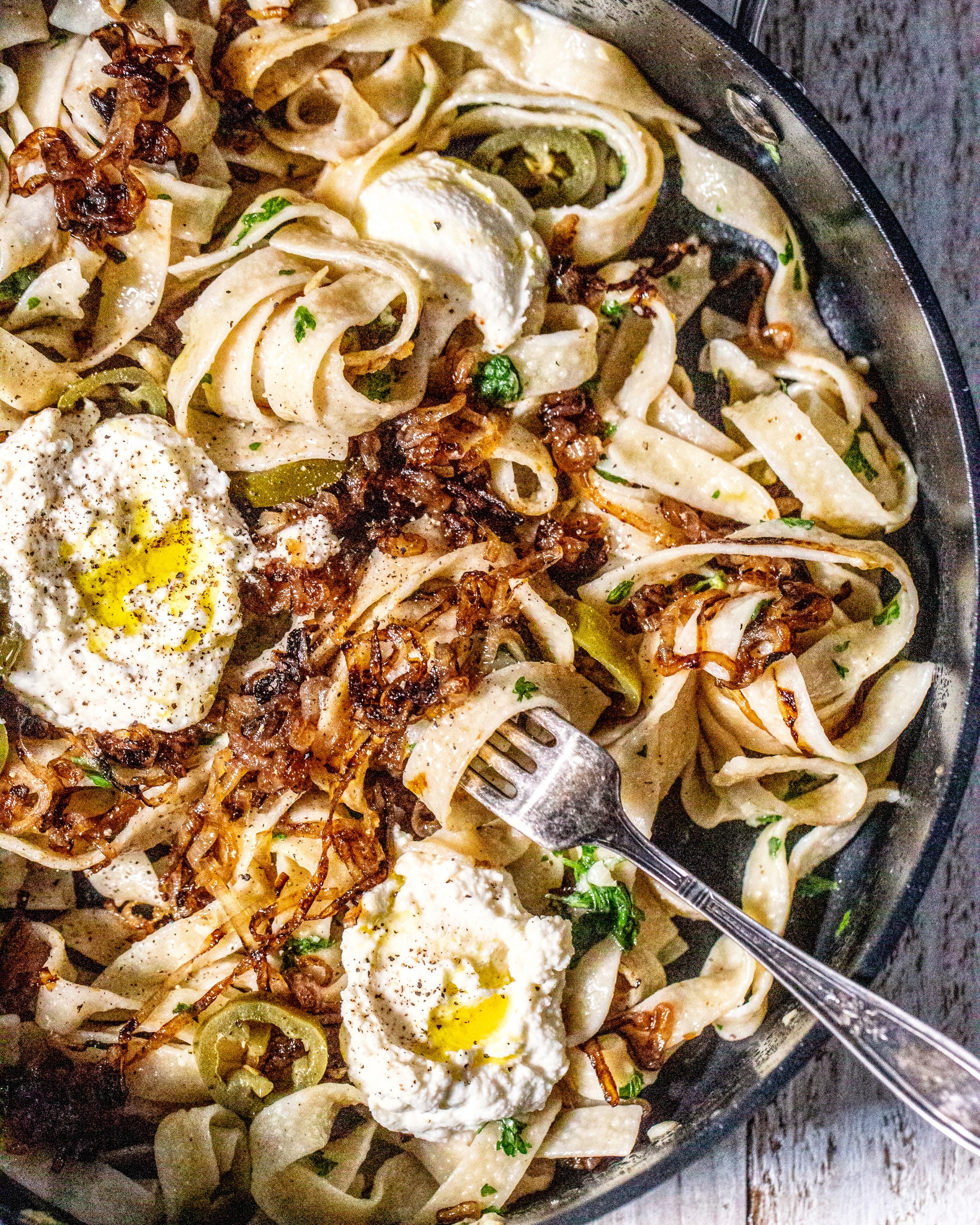

Kitchen Little Essentials
For this recipe, you will need:
A large pot for the pasta (I use this one)
A large skillet for the veggies

Creating this Cacio e Pepe Primavera felt a little like presiding over a marriage. This is truly the joining of two classics – Cacio e Pepe and Pasta Primavera. This is a recipe situation in which the final product is truly better than the sum of its parts, which always feels like a distinct victory, a real kitchen accomplishment, you know? The pasta-to-veggie ratio here is such that you don’t need a side salad or really anything else when you serve this – it is hearty and completely satisfying just as it is.
Filled to the brim with colorful, bright, fresh veggies and swirls and twirls of pasta, this Cacio e Pepe Primavera is the definition of a happy marriage to be sure.

What is Cacio e Pepe?
Sometimes playfully referred to as “Roman Mac and Cheese,” Cacio e Pepe is an Italian classic, the translation of which literally means “cheese and pepper.” It comes together quickly, with only a few meager ingredients that, when wielded properly, create a luscious and cheesy sauce that falls silkily over the noodles. It’s pasta brilliance. It is utterly simple and delicious and, to me, has always made for the perfect pasta side dish; nicely helping to support a protein on a plate, but never quite nailing the role of main course. Until now, that is. Enter pasta primavera …
What is Pasta Primavera?
Pasta Primavera is an American dish that rose to immense popularity in the 1970s. It consists of cooked pasta tossed with a melange of fresh vegetables that have either been roasted or sautéed. The word “Primavera” translates to “spring.” So, I’ve always naturally gravitated toward this recipe at just this time of year … when celebrating the end of winter and the beginning of spring is at its peak.
I think my Mom made Pasta Primavera more than almost any other dish when I was growing up. It’s just so crowd pleasing and family friendly – and a FANTASTIC way to get kids to wolf down their vegetables. I also like it because it’s a great way to use up the odds and ends that you’ve got in your produce drawers. You certainly don’t have to stick to the vegetables that I’ve listed in this recipe – these are just what I like and happened to have on hand. If, for example, you don’t care for leeks or that seems alienating to you – then just use a chopped onion instead. No harm, no foul. This is YOUR primavera, you do you here.


White Pepper vs Black Pepper
I call for white pepper in this recipe, which is definitely not traditional, but I find that by using a combination of white and black pepper, you really amp up the pepper notes in the dish and leave no room for confusion – this is Cacio e PEPE. Pepper diversity creates a layering effect here, and makes the pepper the true star of the show, even after adding all of the vegetables into the mix. White pepper, as an ingredient, is nice to have around for specific occasions, for sure. Here’s the low-down on white pepper.
When to use white pepper?
While black pepper is more common in American kitchens, using white pepper in light-colored dishes for aesthetic reasons (such as white sauces like béchamel and mornay) is a practice that has its roots in French cuisine. White pepper is also used in some cuisines for its specific, hard-to-mimic flavor. You see it fairly often in Chinese dishes, and in aromatic Southeast Asian dishes.

What is the difference between white pepper and black pepper?
Both the fruit of the pepper plant, black peppercorns and white peppercorns are processed differently. Black peppercorns are picked when they’re almost ripe and sun-dried. The sun turns the outer layer black. To make white peppercorns, this outer, dark layer is taken off, leaving only the inner seed behind.
“White pepper tastes hotter – more intense – than black pepper but “it is less complex, with fewer flavor notes. High-quality peppercorns of either type are more aromatic and have more floral, spice, and fruit notes than generic ones. Candy recommends the pungent Muntok white and Tellicherry black peppercorns sold by Pendery’s. Freshness is key to good white pepper, which turns stale and bitter faster than black.” – Chowhound

If you like this recipe you might also enjoy:
Quick Garlicky Miso & Ginger Mazemen
Knockout Pappardelle Bolognese
PrintCacio e Pepe Primavera
A bright and fresh spin on two classic pastas that is ripe for riffing and so flexible – you can use any veggies that you like or have on hand and as much or little of any veggie as you like (my amounts are just suggestions, really). You can also switch up the cheese situation, adding others if you like, just be sure to keep the Parmesan in there. Pecorino would be a nice addition, or Manchego. This is a great way to use up the odds and ends in your produce drawers. This serves up to 6 people.
- Yield: 6 to 8 servings
Ingredients
1 lb. long pasta (such as spaghetti, bucatini or angel hair)
Salt, as needed
2 TBSP olive oil
5 TBSP butter, divided
2 tsp cracked black pepper, plus extra as needed
1 bunch leeks, trimmed, chopped into rounds and rinsed clean of grit
3 carrots, any color, shaved or chopped
6 to 8 stalks asparagus, trimmed of the woodsy ends and chopped
2 cups cherry tomatoes, halved if desired
1 bunch radishes, halved (optional)
1 cup sweet green peas, frozen or fresh
1 tsp white pepper
1-1/3 cups freshly grated parmesan cheese or Grana Padano, plus more if desired
A couple handfuls of arugula
Toasted pine nuts, for topping (see note)
Instructions
Begin by preparing the pasta according to package directions, cooking it in generously salted water (think sea water). Reserve ½ cup of the cooking water prior to draining it.
Meanwhile, add the oil and 2 TBSP of the butter to a large skillet over medium heat. Add the 2 tsp of black pepper and stir to toast it a bit. Next, add the leeks, carrots, asparagus, tomatoes, radishes, and peas. Season to taste with salt and then add the white pepper. Cook until the tomatoes have just burst, about 10 minutes or so; stirring occasionally.
Add the remaining 3 TBSP of the butter, the reserved pasta water, and the cheese. Toss to combine and then add the pasta into the pan (I typically don’t use all the pasta). Toss well to combine everything and to create a rich and creamy sauce. Taste and add more salt and pepper, if needed.
Serve the cacao e pepe primavera with some fresh arugula sprinkled on top and some toasted pine nuts. Enjoy right away.
Notes
To toast pine nuts: cook in a small dry skillet over medium heat until nutty; about 2 to 3 minutes.
Keywords: Cacio e Pepe Primavera
